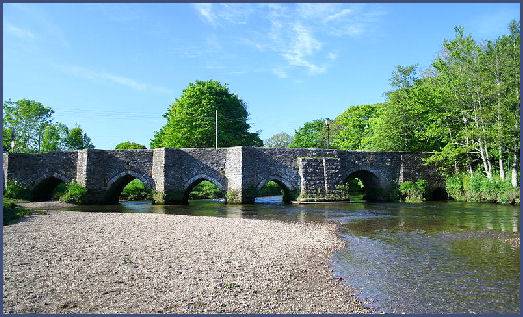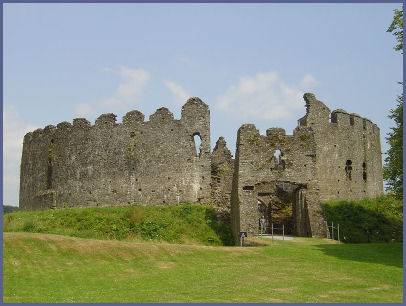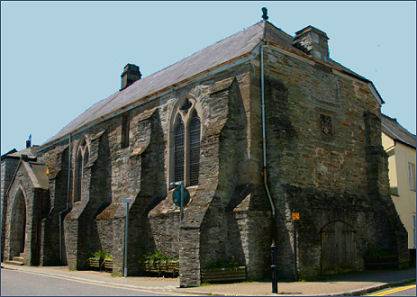Lostwithiel
OS Grid ref:- SX104598
 The historic small town of Lostwithiel lies in a delightfully scenic wooded valley at the head of the Fowey Estuary, the town makes an excellent base for a holiday in Cornwall as it is situated near to both the coast and Bodmin Moor and only a few miles from the Eden Project.
The historic small town of Lostwithiel lies in a delightfully scenic wooded valley at the head of the Fowey Estuary, the town makes an excellent base for a holiday in Cornwall as it is situated near to both the coast and Bodmin Moor and only a few miles from the Eden Project.
The town derives its name from the Cornish Lostwydhyel, meaning the place at the end of the woodland. Founded in the Norman era for the export of tin, the poet John Betjeman is reputed to have said of it "There is history in every stone in Lostwithiel".
The town was once the capital of Cornwall. Edmund, Earl of Cornwall once referred to Lostwithiel as the "the fairest of small cities", Earl Edmund built the Duchy Palace (pictured below left) with its shire hall, exchequer and coinage hall, where tin was once assayed and duty paid. The frontage of the Palace still exists by the river.
 St. Bartholomew's Church, named in honour of the patron saint of tinners, dates back to the thirteenth century, while its handsome octagonal lantern spire, which has Breton influences, was added in the fourteenth century.
St. Bartholomew's Church, named in honour of the patron saint of tinners, dates back to the thirteenth century, while its handsome octagonal lantern spire, which has Breton influences, was added in the fourteenth century.
The spire is massively buttressed and rests upon arches on its north and south sides which were once open, forming a passage through the tower. These arches remained open until 1878 the church underwent extensive renovation, when they were enclosed with oak doors. St. Bartholomew's is a Grade I Listed building, its great eastern window of five lights is reputed to be one of the finest in Cornwall, while the magnificent font dates to the fourteenth century. The church was occupied by Parliamentary forces during the Civil War, when they are believed to have stabled their horse inside the church.
Restormel Castle (right) dramatically bestrides a hill top overlooking the River Fowey around a mile to the north of Lostwithiel . The castle was founded by Robert, Count of Mortain, the half brother of William the Conqueror, in around 1100. It occupies the site of an earlier wooden Norman fort.
Restormel was once home to the famous Edward, the Black Prince, who, as eldest son of King Edward III, was also Prince of Wales and Duke of Cornwall. He covered himself in glory during the Hundred Years War with the French and became the hero of the battles of Crecy and Poiters. The Black Prince visited and occupied Restormel Castle in 1354 and in 1365. The castle saw action in in 1644, when Royalist forces drove out a Parliamentary garrison which had occupied Restormel during the Civil War.
 The Lostwithiel Museum situated in the Old Corn Exchange on Fore Street, hosts a collection of photographs and artefacts reflecting life in the town over the past two centuries. The museum has a varied display of domestic articles, craft tools, agricultural implements, medals, minerals and other artefacts, all given by local people over the years. The largest item on display is Lostwithiel's original eighteenth century hand pumped fire engine.
The Lostwithiel Museum situated in the Old Corn Exchange on Fore Street, hosts a collection of photographs and artefacts reflecting life in the town over the past two centuries. The museum has a varied display of domestic articles, craft tools, agricultural implements, medals, minerals and other artefacts, all given by local people over the years. The largest item on display is Lostwithiel's original eighteenth century hand pumped fire engine.
Lostwithiel Bridge (pictured above) is one of the oldest in Cornwall, dating back to the thirteenth century. Guided walks of the historic Cornish capital are available in the summer months. The town boasts numerous antique shops and a variety of accommodation and there are excellent walks in the area.
Boconnoc House near Lostwithiel is linked to one of the most famous jewels in history, the Pitt Diamond. The country estate is steeped in history including the story of how King Charles I once hid in one of the bedrooms during the Civil War. It includes the largest landscaped park in Cornwall.
The nearby pleasant hamlet of St Winnow is home to the interesting Farm Museum, the church of St. Winnow occupies the site of what was once a seventh century Celtic monastery and has handsome stained glass windows and carved bench ends.